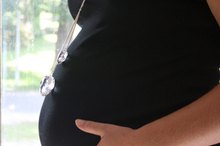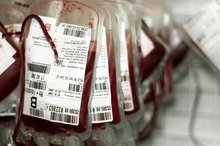Causes of Fluid Around the Heart in a Fetus
Excessive fluid buildup around the heart, known as pericardial effusion, can be diagnosed on fetal ultrasound. Pericardial effusion can interfere with the heart’s ability to pump blood to the rest of the body, affecting growth and vitality of the fetus. A number of conditions can cause accumulation of fluid around the fetal heart.
Rh Disease
The Rh factor is a protein found on red blood cells in 85 percent of people who are said to be Rh-positive. Rh disease develops in an Rh-positive fetus whose mother is Rh-negative. Rh disease doesn’t develop until a woman has had at least one pregnancy. Fetal blood cells cross the placenta in small amounts and cause the mother to develop antibodies which attack the abnormal blood cells. In subsequent pregnancies, the antibodies cross the placenta and attack the blood of an Rh-positive fetus. Red blood cells are destroyed and the fetus becomes severely iron deficient. The fetus retains fluid, or edema, which may occur around the heart. This fluid may be visible on ultrasound when the fetal hemoglobin drops below the normal levels for gestational age of the fetus.
- The Rh factor is a protein found on red blood cells in 85 percent of people who are said to be Rh-positive.
- In subsequent pregnancies, the antibodies cross the placenta and attack the blood of an Rh-positive fetus.
Twin to Twin Transfusion Syndrome
Signs & Symptoms of Down Syndrome During Pregnancy
Learn More
Twin to twin transfusion syndrome, also called TTTS, affects only identical twins, especially those who share the same amniotic sac. Identical twins, who develop from the same embryo, share a placenta. As blood circulates through the placenta, one twin may end up with too much blood circulating and the other may not have enough blood. Both twins may develop heart failure, but for different reasons.
- Twin to twin transfusion syndrome, also called TTTS, affects only identical twins, especially those who share the same amniotic sac.
- Identical twins, who develop from the same embryo, share a placenta.
Other Causes
Several other conditions can cause fluid accumulation around the heart in a fetus. Fetal heart failure leads to pericardial effusion. Congenital heart disease and heart arrhythmias may cause fluid accumulation. Cysts, infection and an abnormal opening between the abdomen and chest cavity, can also lead to pericardial effusion. Pericardial effusion on ultrasound may also indicate an increased risk of Down syndrome in a fetus 1.
- Several other conditions can cause fluid accumulation around the heart in a fetus.
Related Articles
References
- Cleveland Clinic. Pericardial Effusion.
- UT Southwestern Medical Center. Pericardial Effusion.
- Ghosh, A., Crake, T., Manisty, C., and M. Westwood. Pericardial Disease in Cancer Patients. Current Options in Cardiovascular Medicine. 2018. 20(7):60. doi:10.1007/s11936-018-0654-7
- Kato, R., Hayashi, H., Chiba, Y. et al. Prognostic Impact of Minimal Pericardial Effusion in Patients With Advanced Non-Small-Cell Lung Cancer. Clinical Lung Cancer. 2017 May 10. doi:10.1016/j.cllc.2017.05.011
- Mizukami, Y., Ueda, N., Adachi, H., Arikura, J., and K. Kondo. Long-Term Outcomes after Video-Assisted Thoracoscopic Pericardiectomy for Pericardial Effusion. Annals of Thoracic and Cardiovascular Surgery. 2017 August 9. doi:10.5761/atcs.oa.17-00046
- National Cancer Institute. Cardiopulmonary Syndromes (PDQ): Health Professional Version.
- Ning, M., Tang, L., Gomez, D. et al. Incidence and Predictors of Pericardial Effusion After Chemoradiation Therapy for Locally Advanced Non-Small Cell Lung Cancer. International Journal of Radiation Oncology, Biology, and Physics. 2017. 99(1):70-79. doi:10.1016/j.ijrobp.2017.05.022
Writer Bio
A registered nurse with more than 25 years of experience in oncology, labor/delivery, neonatal intensive care, infertility and ophthalmology, Sharon Perkins has also coauthored and edited numerous health books for the Wiley "Dummies" series. Perkins also has extensive experience working in home health with medically fragile pediatric patients.






